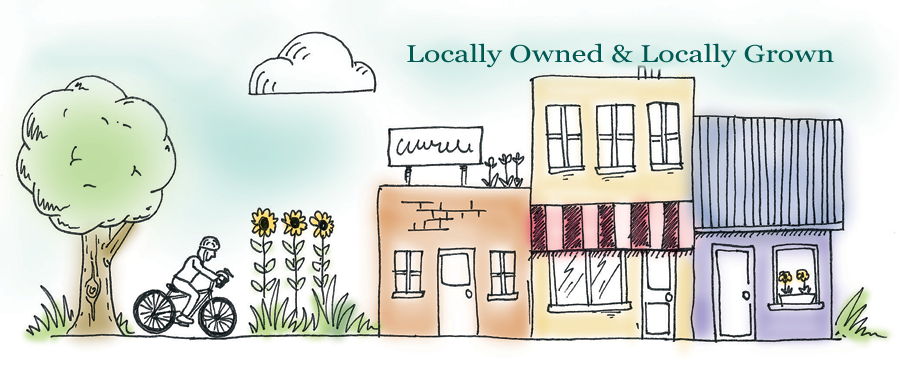Locally Owned & Locally Grown
The attached guide celebrates the stories of the many brave pioneers who have taken risks to become leaders in the locavore movement. In doing so, they have supported the publication of Edible Louisville® & the Bluegrass with their precious marketing dollars because they want their message to reach out to you — our wonderful readership.
It is because of their dedicated efforts that Kentucky and Southern Indiana have gained national attention as foodie community, as well as a great place to live.
As you read these stories, we hope you will feel inspired to visit them, thus making an investment in your hometown with your dollars. No doubt you will discover new culinary delights, a few treasures, and make some new friends along the way.
Please click on the image below to open a PDF of the guide in a new window.
Why Buy Local Food?
Locally grown food tastes better. Food grown in your own community was probably picked within the past 24 hours. It’s crisp, sweet and loaded with flavor. Produce flown or trucked in from California, Florida, Chile, or Holland is obviously much older. Several studies have shown that the average distance food travels is 1,500 miles in a week long or more delay from harvest to dinner table, sugars turn to starches, plant cells shrink and produce loses vitality. Tasteless but durable Florida tomatoes are the poster child for industrialized produce.
Local produce is better for you. A recent study showed that fresh produce loses nutrients quickly. Food that is frozen or canned soon after the harvest is actually more nutritious than some “fresh” produce that has been on the truck or supermarket shelf for a week. Locally grown food, purchased soon after harvest retains it nutrients.
Local food preserves genetic diversity. In the modern industrial agriculture system, varieties are chosen for their ability to ripen simultaneously and withstand harvesting equipment; for a tough skin that can survive packing and shipping, and for an ability to have a long shelf life in the store. Only a handful of hybrid varieties of fruits and vegetables meet these rigorous demands, so there is little genetic diversity in the plants grown. Local farms, in contrast, grow a huge number of varieties to provide a long season of harvest; an array of eye-catching colors, and the best flavors. Many are heirlooms and these old varieties contain genetic material from hundreds or thousands of years of human selection; they may someday provide the genes needed to create varieties that will thrive in a changing climate.
GMO free. Biotechnology companies have been commercializing genetically modified fruits and vegetables generally by licensing to large factory-style farms. Most farmers serving local farmers markets avoid GMOs. If you are concerned about genetically-modified foods, you can speak to local farmers about the seeds they use. And you can support organic practices in your region, the old-fashioned way as nature intended.
Local food supports local farm families. With fewer than one million Americans now claiming farming as their primary occupation, farmers have become a vanishing breed. Commodity prices are low compared to the cost of production. Reportedly the farmer often gets less than 10 cents on the retailer food dollar. Local farmers who sell direct to consumers cut out the middle man and get full retail prices for their food — which means families can afford to stay on the farm, doing the work they love. When you buy from a local producer, you are not helping to improve the stock portfolio of CEO and shareholders that lives in another state or possibly another country. You are helping someone who lives in your region put food on the table and you help them sustain their family. People who farm are doing it out of passion, not out of a need to be rich.
Local food builds community. When you buy direct from the farmer, you are re-establishing a time-honored connection between the eater and the grower. Knowing the farmer gives you insight into the seasons, the weather, and the miracle of raising food. Compare the number of conversations that take place at a farmers market as opposed to shopping at a super-store.
Local food preserves open space. As the value of direct marketed fruits & vegetables increases, selling farmland for development becomes less likely. Appreciate driving out into the country and observing the fields of crop, the meadows of wildflowers, and the picturesque barns. That landscape will survive only as long as farms are financially viable. When you buy locally grown food, you are doing something proactive about preserving the agricultural landscape.
Local food supports a clean environment. A well-managed family farm is a place where the resources of fertile soil and clean water are valued. Good stewards of the land grow cover crops to prevent soil erosion and replace nutrients used by their crops. Cover crops also capture carbon emissions and help control global warming. According to some estimates, farmers who practice conservation tillage could sequester 12-14% of the carbon emitted by vehicles and industry. In addition, the patchwork of fields, meadows, woods, ponds and buildings — is the perfect environment for many species of wildlife.






